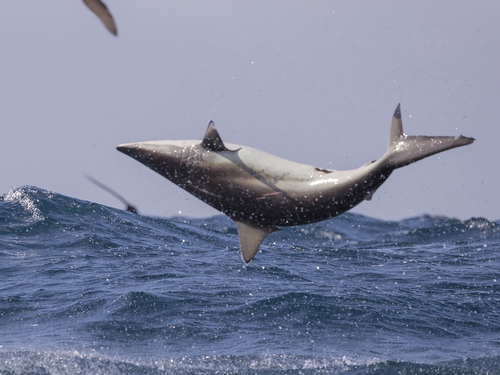
Spinner Shark
Bluefin Tuna, belonging to the genus Thunnus, are among the most impressive fish in the ocean. Known for their size, speed, and commercial value, they are apex predators that play a crucial role in marine ecosystems. These highly migratory fish are found in various oceans around the world.
15 20 years
Lifespan
300 cm
Length
Vulnerable
Conservation Status
32 km/h
Swimming speed
Carnivorous
Diet
Highly Migratory, Seasonal Migration
Migration
Appearance Overview
The Bluefin Tuna is renowned for its sleek, torpedo-shaped body, perfectly adapted for speed and endurance in the water.
Color
Dark metallic blue on top with a silvery underside
Fins
Two dorsal fins, the first is depressible, followed by small finlets
Body
Streamlined, robust body built for speed
Length
Up to 10 feet (3 meters), commonly 6.5 feet (2 meters)
Weight
Up to 1,500 lbs (680 kg), commonly 550 lbs (250 kg)
Diet
Carnivorous, feeding on fish, squid, crustaceans, and occasionally on plankton and other small organisms.
Feeding Behavior
Uses speed and agility to chase down prey, often hunting in coordinated schools, particularly when targeting smaller fish.
Social Behavior
Highly migratory, forming large schools, especially during spawning season; known to travel vast distances across oceans.
Commercial Relevance
Extremely high value in sushi and sashimi markets, particularly in Japan, where it can fetch incredibly high prices at auction.
Conservation measures
International fishing quotas, marine protected areas, fishing gear restrictions, and efforts to reduce bycatch.
Status
Varies by species: Atlantic Bluefin Tuna - Endangered, Pacific Bluefin Tuna - Vulnerable, Southern Bluefin Tuna - Critically Endangered.
Threats
Overfishing, primarily driven by high demand in sushi markets, climate change affecting migration patterns, and habitat degradation.
Habitat Distribution
Depth Range
0-900 meters, though they are capable of diving much deeper in search of food.
Geographic Range
Atlantic Ocean, Pacific Ocean, Mediterranean Sea, and the Southern Ocean (depending on the species).
Preferred Environment
Temperate and subtropical waters; highly migratory, often found in both coastal and open ocean environments.
Reproduction and Life Cycle
Breeding Habits
Spawns in warm waters, such as the Gulf of Mexico and the Mediterranean Sea, with specific spawning grounds varying by species.
Development Stages
Larvae hatch in plankton-rich waters and grow rapidly, transitioning through juvenile stages before reaching adulthood.
Fecundity
Females can produce millions of eggs per season, releasing them into the water column where they are fertilized externally.
Maturity Age
Matures at 4-8 years for Atlantic Bluefin, earlier for smaller species; age at maturity can vary with environmental conditions.
Faqs about Spinner Shark
How fast can Bluefin Tuna swim?
Bluefin Tuna are among the fastest fish in the ocean, capable of reaching speeds up to 43 mph (70 km/h).
What is the lifespan of a Bluefin Tuna?
Bluefin Tuna can live up to 40 years, though this varies by species and environmental conditions.
Are Bluefin Tuna warm-blooded?
Yes, they are warm-blooded, which allows them to maintain high body temperatures and swim at high speeds in cold waters.
How are Bluefin Tuna typically caught?
Bluefin Tuna are primarily caught using purse seine nets, longlines, and sometimes by rod and reel.
What is the highest price ever paid for a Bluefin Tuna?
The highest price paid for a Bluefin Tuna was over $3 million for a 612-pound fish at a Tokyo auction.
How can consumers help in the conservation of Bluefin Tuna?
Consumers can look for sustainably sourced tuna certifications, support sustainable fishing practices, and reduce consumption of overfished species.
Copyright @ Nature Style Limited. All Rights Reserved.
 English
English